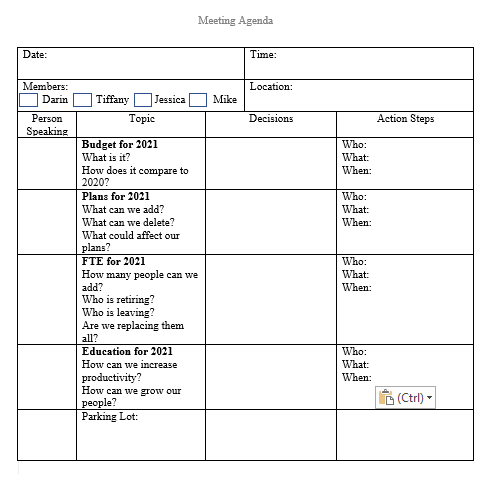Have you ever gone to a meeting only to find that someone didn’t do their assignment? Instead of being able to move forward you must reassign the task and possibly rehash the same information.
Frustrating, isn’t it? Most of the time this is not a person error, but a process error. Let me explain.
For a few weeks I have been sending my husband an article to edit and post on enlivenIT.org. Each day I would get a reminder that alerted me to complete this task. This was my prompt.
Last week was busy. I was making food for a family get together and a benefit that was coming up. My focus was on the shopping and prepping of food.
And then, for some reason, the reminders stopped coming. Because of this, I did not send an article to my husband which caused a disruption in the flow. It also caused us to be out of synch.
It wasn’t that I didn’t want to write an article, but that I was busy. Because I didn’t get my prompt, it totally slipped my mind.
After we became friends again, we decided to ensure that an alert was sent to me weekly. This would be my trigger to get me thinking about the article and keep us in step.
In a business setting, especially at meetings, people sometimes don’t get their action steps completed. There are a few reasons for this that revolve around confusion about decisions, tasks or responsibilities.
When confronted with not getting things done, they spend more time covering their backsides than looking for solutions. Creating a communication system can help with these process breakdowns.
Michael Hyatt in his book No-Fail Communication mentions 4 things to include in your communication system to capture and disseminate information.
Designate a facilitator
A facilitator is someone who takes detailed notes during a meeting and ensures that all parties receive a copy. This person is not the leader, as the leader is busy driving the meeting.
The facilitator’s job is to document the meeting correctly by recording any decisions or outcomes, and the responsible person to ensure that no one drops the ball.
Use The One Conversation Rule
Make a rule that there is only one conversation going on during the meeting. This means no sidebars.
I actually like this rule as it is hard for me to listen to the meeting and my neighbor at the same time. If someone brings up something that is a different topic than the one being discussed, it should be talked about later according to the agenda of the meeting.
If it’s not on the agenda, it should be put in the parking lot (waiting area) and discussed if there is time at the end of the meeting. If there isn’t time, the team can decide if that topic is important enough to make it to the next meeting’s agenda.
Write Notes
Every conversation that has a decision or action items should be written down. I am a firm believer in writing things down and love Post-It notes for this reason.
According to Listening Statistics: 23 Facts You Need to Hear, people spend between 70-80% of their day engaged in some form of communication, and about 55% of their time devoted to listening. Most people usually only remember 17-25% of the things they listen to (Lake, R., 2015).
Therefore, since I know that my memory is not always accurate (I’m assuming yours isn’t either), I choose to write things down so I can remember them correctly.
Use communication templates
A template is a guide or pattern used in creating something. For our purposes, we want to create a template that we can use at every meeting.
This template will capture the date, team members present and absent, topics of discussion, the decision points, and any action to be taken. The action section will include the owner, the task, and a deadline for when it will be completed.
The template is a great guide for the meeting and for the person taking the notes. At my workplace, I am frequently called on to be a facilitator.
We have a template where the leader puts together the topics and the order in which they will be discussed. I then go into the agenda and make spaces and prepare the agenda for the meeting.
Here is an example of a template for a meeting. This way, I am ready for the meeting and can write on whatever topic is being discussed at the current time.

Small Steps
To help improve your processes and to ensure clear communication use these 4 rules. Write things down and ensure that everyone knows what action steps they are responsible for.
What process can you improve on today? Write your thoughts in the comments below.
